The Garmin Nuvi 1390 has a unique speed camera warning system to help you drive safely and an optional CityXplorer download which will even direct you via public transport (information varies between cities) or give you instructions for walking to your destination in stead of using your car so you can use your sat-nav anywhere.
MiNe's
Firstly, I would like to share about my story and my lovely toys, the Yamaha 135lc and the Honda Civic EJ. Both of it are are my lovely transport since I was young. Since I was 10 years old, I am very excited with cars and motorcycles especially it is a bike. A big cc engine bike and a modified engine cars are my favourites. Wow! I am very excited about it. Although some people said when someone going to modified a car or something to fulfill their passion with speed.. it actually wrong for me because, yes many people like to modified cars to make them go faster but in my mind, I didn't think to have more speed because I am a person who like to hear the sound of a big engine. If who is really expert about the sound only can tell us what is the meaning of an engine's sound. It is very nice to hear because every engine has it own story that make them have different sound and I love it. When I was 19 years old, I get my own Yamaha 135 lc and when I'm 20, I has get my lovely car the Civic EJ. At my 135lc, there was a number 11. I know people will wondering what is the meaning of the 11. It actually is my lovely person number. If I took a ride lonely, the number 11 will make me feel that she is with me..huhu =D ..Back to the stoy, I am very take a good care and love my toys like I take care of a child.=)
My Activities..
Sunday 27 November 2011
MiNe's Little Business.. (GARMIN GPS)
The Garmin Nuvi 1390 has a unique speed camera warning system to help you drive safely and an optional CityXplorer download which will even direct you via public transport (information varies between cities) or give you instructions for walking to your destination in stead of using your car so you can use your sat-nav anywhere.
MiNe's Little Business..
Ideal for individuals who enjoy music with their active lifestyle, the Nokia Bluetooth Stereo Handset BH-503 brings you music and call handling - all in wireless freedom. Enjoy style in comfort with music played back in Hi-Fi stereo quality coupled with an ergonomic neckband design.
- enjoy high-quality stereo sound streamed from your compatible phone
- stay comfortably in style with over the ear and an ergonomic neckband design
- control the music player and manage your calls with the integrated media keys
- save time with fast charging
BLUETOOTH..
The word "Bluetooth" is an anglicised version of the Scandinavian Blåtand/Blåtann, the epithet of the tenth-century king Harald I of Denmark and parts of Norway who united dissonant Danish tribes into a single kingdom. The implication is that Bluetooth does the same with communications protocols, uniting them into one universal standard.
Name and logo
Implementation
Bluetooth uses a radio technology called frequency-hopping spread spectrum, which chops up the data being sent and transmits chunks of it on up to 79 bands (1 MHz each; centered from 2402 to 2480 MHz) in the range 2,400-2,483.5 MHz (allowing for guard bands). This range is in the globally unlicensed Industrial, Scientific and Medical (ISM) 2.4 GHz short-range radio frequency band.
Communication and connection
Uses
| Class | Maximum permitted power | Range (m) | |
|---|---|---|---|
| (mW) | (dBm) | ||
| Class 1 | 100 | 20 | ~100 |
| Class 2 | 2.5 | 4 | ~10 |
| Class 3 | 1 | 0 | ~5 |
| Version | Data rate | Maximum application throughput |
|---|---|---|
| Version 1.2 | 1 Mbit/s | 0.7 Mbit/s |
| Version 2.0 + EDR | 3 Mbit/s | 2.1 Mbit/s |
| Version 3.0 + HS | Up to 24 Mbit/s | See Version 3.0+HS. |
| Version 4.0 | Up to 24 Mbit/s | See Version 3.0+HS. |
WAAS..
WAAS..
What is WAAS?
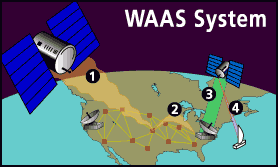
The origins of WAAS
How it Works
Who benefits from WAAS?
It just keeps getting better
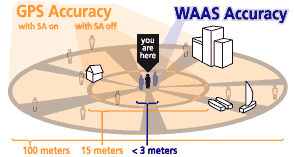
GPS..
What is GPS?
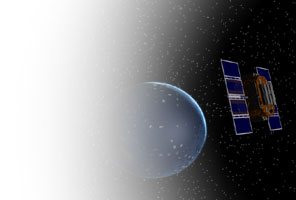
How it works
How accurate is GPS?
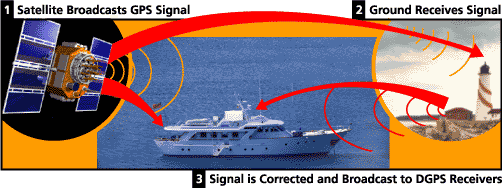
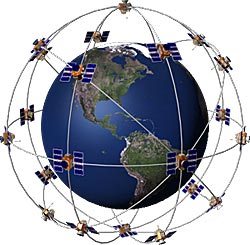
The GPS satellite system
- The first GPS satellite was launched in 1978.
- A full constellation of 24 satellites was achieved in 1994.
- Each satellite is built to last about 10 years. Replacements are constantly being built and launched into orbit.
- A GPS satellite weighs approximately 2,000 pounds and is about 17 feet across with the solar panels extended.
- Transmitter power is only 50 watts or less.
What's the signal?
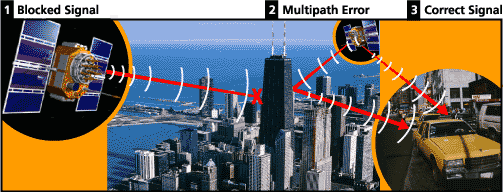
Sources of GPS signal errors
- Ionosphere and troposphere delays - The satellite signal slows as it passes through the atmosphere. The GPS system uses a built-in model that calculates an average amount of delay to partially correct for this type of error.
- Signal multipath - This occurs when the GPS signal is reflected off objects such as tall buildings or large rock surfaces before it reaches the receiver. This increases the travel time of the signal, thereby causing errors.
- Receiver clock errors - A receiver's built-in clock is not as accurate as the atomic clocks onboard the GPS satellites. Therefore, it may have very slight timing errors.
- Orbital errors - Also known as ephemeris errors, these are inaccuracies of the satellite's reported location.
- Number of satellites visible - The more satellites a GPS receiver can "see," the better the accuracy. Buildings, terrain, electronic interference, or sometimes even dense foliage can block signal reception, causing position errors or possibly no position reading at all. GPS units typically will not work indoors, underwater or underground.
- Satellite geometry/shading - This refers to the relative position of the satellites at any given time. Ideal satellite geometry exists when the satellites are located at wide angles relative to each other. Poor geometry results when the satellites are located in a line or in a tight grouping.
- Intentional degradation of the satellite signal - Selective Availability (SA) is an intentional degradation of the signal once imposed by the U.S. Department of Defense. SA was intended to prevent military adversaries from using the highly accurate GPS signals. The government turned off SA in May 2000, which significantly improved the accuracy of civilian GPS receivers.





